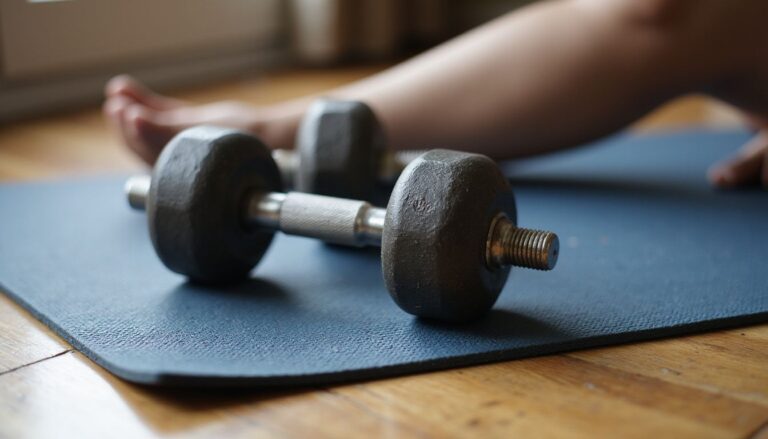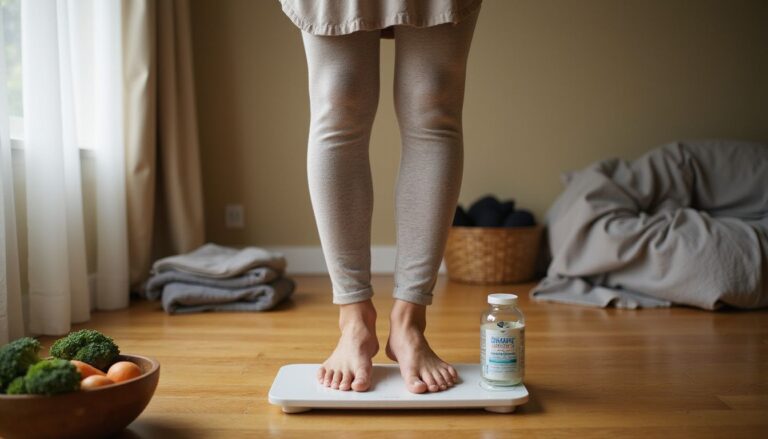Top High Protein Low Fat Foods: Your Ultimate Guide To Nutritious Protein-Rich And Low-Fat Options
Our Nutrition Assistant AI Suite will transform your body. You will lose fat, get toned, and build muscle. Gain confidence and optimal health.
Choosing foods that keep you full and support your goals can be tough. High-protein, low-fat options give you plenty of protein with fewer calories from fat. This approach supports weight management and steady energy.
This guide brings you clear facts, simple nutrition data, and expert tips. You will see which foods are high in protein, how they fit into a healthy diet, and how to use them in meals and snacks. Small changes add up, and they can improve how you feel each day.
Key Takeaways
- High-protein, low-fat foods such as skinless chicken breast (55.9 g protein, 5.64 g fat per 174 g) and turkey breast (30.1 g protein, 2.08 g fat per 100 g) can support weight control and muscle growth.
- Plant choices like tofu (10.9 g protein, 4.19 g fat per 100 g), edamame (11.2 g protein, 4.73 g fat per 100 g), and quinoa (8.14 g protein, 3.55 g fat per cup) provide complete proteins or strong amino acid profiles with little fat.
- Higher-protein eating plans are linked to better fullness, lower daily calories, fewer cravings, and less weight regain according to systematic reviews.
- Nonfat Greek yogurt (16.1 g protein, 0.577 g fat per 156 g) and egg whites (about 4 g protein per egg white) deliver quality animal protein without extra fat or cholesterol.
- Experts suggest lean meats, low-fat dairy, and plant protein while limiting processed meats and high-fat foods to lower chronic disease risk.

Benefits of Eating High Protein, Low Fat Foods

High-protein foods can strengthen your meal plan and help with weight goals. These options are nutrient-dense, so you get more protein per bite with less fat and fewer calories.
How Do High Protein, Low Fat Foods Help with Weight Management?
Protein increases fullness, which can help you eat fewer calories across the day. Research shows that higher-protein diets support weight loss and reduce weight regain over time. Many people also notice fewer cravings and better appetite control.
For example, peanut butter powder has about 85 to 90 percent less fat and 65 to 70 percent fewer calories than regular peanut butter. Swapping it can lower daily fat and calorie intake. A Mediterranean-style pattern that includes lean protein is often used for weight control. Pairing high-protein foods with a calorie deficit may also reduce belly fat.
Dietitians often suggest eating four to five small meals or snacks per day. This pattern can steady hunger and make your plan easier to follow.
Choosing high protein, low fat foods can help you feel satisfied while cutting calories.
Protein does more than support weight goals. It also helps your body repair and rebuild muscles after activity.
Why Are These Foods Important for Muscle Building and Recovery?
Protein supplies amino acids, the building blocks your muscles need to repair and grow. Adults, especially those over age 50, may benefit from about 1 gram of protein per kilogram of body weight per day to maintain muscle.
Lean choices like skinless chicken breast or fish work well. A 3 ounce portion of cooked chicken breast has about 26 grams of protein. A similar amount of fish often provides 17 to 20 grams.
Complete proteins give you all nine essential amino acids. These support enzymes, hormones, immune function, and tissue repair after workouts. A higher-protein plan can also slow age-related muscle loss. Options like soy, quinoa, or nonfat Greek yogurt can help you recover faster and preserve strength.
What Are the Overall Health Benefits of High Protein, Low Fat Foods?
Protein supports bones, immune cells, and healthy blood. A mix of lean animal and plant sources can provide all essential amino acids. Replacing red meat with plant protein may lower the risk of heart disease.
One 2022 study found that replacing 5 percent of daily calories from carbs with plant protein was linked to a 26 percent lower risk of dementia. Balanced, high-protein meals can also steady blood sugar and support a healthy metabolism.
Lean picks like nonfat Greek yogurt or egg whites add protein without much saturated fat. In my home, adding more lean meats and beans helped me feel full longer and lose weight steadily across several months.
Summary: Protein helps with fullness, muscle repair, and long-term health. Lean choices pack a protein punch with less fat and fewer calories.
Best Animal-Based High Protein, Low Fat Foods
Animal foods can be high in protein and low in fat. They also offer iron, vitamin B6, and omega-3 fatty acids, which support heart and brain health.
What Makes Skinless Chicken Breast a Good Choice?
Skinless chicken breast is a classic lean protein. A 174 g serving provides 55.9 g of protein and only 5.64 g of fat. It is low in saturated fat and cholesterol, meeting common nutrition guidelines from the United States Department of Agriculture.
A 3 ounce cooked portion gives about 26 g of high-quality protein with very little fat compared with many red meats. This helps with weight control, muscle recovery, and heart health.
Why Choose Turkey Breast for Protein?
Turkey breast delivers a lot of protein with very little fat. In 100 g of cooked, skinless turkey breast, you get 30.1 g of protein and 2.08 g of fat. That strong protein-to-fat ratio makes it ideal for weight loss and muscle gain.
It is also lower in cholesterol and saturated fat than many other animal proteins. Add sliced turkey to salads and wraps, or pair it with roasted vegetables for a fast, lean meal.
How Can Pure Egg Whites Boost Your Protein Intake?
Egg whites are almost pure protein. One large egg white has about 4 g of protein with almost no fat or cholesterol. Removing the yolk lowers saturated fat and calories while keeping the protein that helps repair muscle.
They are easy to prep in batches for grab-and-go snacks. Many athletes use egg whites to help reach daily protein goals. If you want fullness with few calories, egg whites fit well.
Which White Fish Are High in Protein and Low in Fat?
White fish like tilapia, cod, haddock, and whiting provide impressive protein with very little saturated fat. A typical 3 ounce fillet gives 17 to 20 grams of protein.
As one example, 90 grams of baked whiting provides 20.5 grams of protein and only 5.54 grams of fat. Grill, bake, or steam these fish for simple meals that boost your protein intake.
Are Shrimp a Nutritious High Protein Option?
Shrimp are another fast, lean seafood. A 3 ounce, or 85 g, serving has 17.1 g of protein and only 0.433 g of fat. That is far less fat than most meats.
They cook quickly, which helps on busy nights. I keep a bag of frozen shrimp for easy stir-fries, tacos, or salads. The speed and versatility help me stay on track.
What Are the Benefits of Nonfat Greek Yogurt?
Nonfat Greek yogurt delivers a lot of protein with minimal fat. One 156 g container provides 16.1 g of protein and only 0.577 g of fat. The thick texture keeps you full, which can reduce snacking.
It also supplies calcium for bones and probiotics that support digestion. I often use it for breakfast parfaits or as a base for dips. For a smaller portion, 4 ounces of low-fat yogurt has about 6 grams of protein.
Greek yogurt contributes vitamin D and B vitamins that help with energy and metabolism. It is a smart add-in for both low-fat and plant-forward diets.
Why Include Low-Fat Cottage Cheese in Your Diet?
Low-fat cottage cheese is rich in casein, a slow-digesting dairy protein that supports recovery. One cup, about 220 g, gives 24.2 g of protein and 5 g of fat. A half-cup serving offers 12.4 g of protein.
The protein helps you stay satisfied, which may support weight goals. Cottage cheese pairs well with fruit for a sweet snack, or with tomatoes and herbs for a savory bowl.
Leading Plant-Based High Protein, Low Fat Foods
Plant protein can be powerful. You also get fiber, minerals, and helpful plant compounds that support long-term health.
What Are the Protein Benefits of Tofu and Tempeh?
Firm tofu provides 10.9 g of protein and 4.19 g of fat per 100 g. A 3 ounce serving has about 9 g of protein. Tofu is a complete protein, which means it contains all nine essential amino acids your body needs but cannot make.
Tofu and tempeh both come from soybeans. They are low in saturated fat and contain no cholesterol. I swap tofu into stir-fries and salads for an easy, lean protein that cooks fast. Tempeh is great in sandwiches and grain bowls.
How Do Lentils and Beans Provide Protein?
Lentils and beans supply protein and fiber, a powerful combination for fullness and gut health. One hundred grams of cooked lentils has 23.6 g of protein with only 1.92 g of fat in the data set provided. Canned black beans offer 6.91 g of protein and 1.27 g of fat per 100 g.
A half-cup of cooked lentils adds about 9 g of protein. A half-cup of cooked kidney beans provides around 7.7 g. Add legumes to soups, salads, and bowls to raise your daily protein without much fat.
Why Is Edamame a Good Plant-Based Protein Source?
Edamame is young soybean, and it is a convenient protein. One hundred grams offers 11.2 g of protein with 4.73 g of fat. Edamame is a complete protein and works in snacks, salads, or stir-fries.
It is also gluten-free and cholesterol-free. If you are looking to boost protein using plants, edamame is a simple, tasty choice.
How Can Chickpeas Increase Protein Intake?
Chickpeas contain 20.5 g of protein and 6.04 g of fat per 100 g. Toss them into salads, blend into hummus, or roast for a crunchy snack. They help you reach protein targets without much fat.
Chickpea pasta is another option. One 56 g serving provides 11 g of protein and 3.5 g of fat. It has more protein and fiber than traditional pasta. During college, I used chickpea pasta for quick dinners and felt fuller longer.
What Nutritional Value Does Quinoa Offer?
Cooked quinoa provides 8.14 g of protein and 3.55 g of fat per cup. It is a complete protein and also gluten-free. Quinoa brings fiber, vitamins, and minerals that support digestion and overall health.
It contains plant compounds like kaempferol that are being studied for possible protective effects. Many athletes use quinoa as a base for balanced, recovery-friendly meals.
Are Peas a Reliable Source of Protein?
Peas offer steady plant protein. One cup of boiled peas, about 160 g, contains 5.23 g of protein with only 0.368 g of fat. They are high in dietary fiber and easy to add to many dishes.
Pea protein appears in dairy alternatives and powders for shakes. I often add a half-cup of peas to lunch salads for extra protein with almost no added fat. People also enjoy black-eyed pea dishes for similar reasons.
Peas are useful if you aim for about 1 gram of protein per kilogram of your body weight each day; they support heart health and weight goals.
What Are Some High Protein, Low Fat Snacks?
Snacks can help you meet daily protein needs. They also support muscle repair and steady energy between meals.
How to Make Nonfat Greek Yogurt with Fresh Berries?
Nonfat Greek yogurt with berries is a simple, high-protein snack. A 156 g container provides 16.1 g of protein and only 0.577 g of fat.
- Choose a single-serve container of nonfat Greek yogurt for quick protein with low fat.
- Wash a handful of berries, such as strawberries, blueberries, or raspberries, for fiber and antioxidants.
- Layer the berries on the yogurt for flavor without much fat or added sugar.
- Add a tablespoon of sliced almonds for crunch and minerals; keep the portion small.
- Stir to blend the flavors while keeping calories modest.
- Use this snack after exercise to support muscle recovery.
- For extra protein, mix in half a scoop of whey protein powder to reach more than 20 grams per serving.
- If you want a lighter option, 4 ounces of low-fat yogurt gives about 6 grams of protein.
- Store leftover berries in the fridge for fast repeats during the week.
- Pair this yogurt cup with egg whites or roasted chickpeas if you need more than 10 grams of protein per snack.
- This balanced snack can support people managing Diabetes because it is high in protein and fiber with low added sugar.
Why Choose Hard-Boiled Egg Whites for Snacking?
Hard-boiled egg whites are simple and portable. They deliver clean protein with almost no fat.
- Each large egg white has close to 4 g of protein with almost no fat, helpful for muscle repair.
- They contain no cholesterol, which supports heart-friendly eating plans.
- Cook ahead and pack for work, school, or the gym.
- Low in calories, they can improve fullness between meals.
- Egg whites provide minerals like potassium and magnesium that support daily functions.
- Season with herbs or spices instead of heavy dressings.
- Athletes like them for quick recovery fuel.
- As a student athlete, I carried egg whites in a small container. It kept me satisfied during long study sessions.
- Two egg whites supply about 8 grams of protein for a lean snack.
What Are the Benefits of Crunchy Roasted Chickpeas?
Roasted chickpeas bring crunch and flavor with protein and fiber. They make a satisfying swap for chips.
- At 100 g, chickpeas provide about 20.5 g of protein with only 6.04 g of fat.
- A crisp texture satisfies cravings for crunchy foods.
- Fiber supports fullness and a healthy digestive system.
- Season with spices like garlic powder or paprika to keep sodium and fat in check.
- Chickpeas bring iron and magnesium, key minerals for active bodies.
- Plant protein supports muscle repair and suits people limiting animal products.
- Rinse canned chickpeas, toss with a touch of oil and spices, then bake until crisp.
- Easy to pack, so you can stay on track during busy days.
- I swapped chips for roasted chickpeas during a weight loss phase. Cravings dropped and energy stayed steady.
How Does Edamame Serve as a Quick Protein Snack?
Edamame is fast to prepare and nutrient-dense. It fits both plant-based and mixed diets.
- Edamame has 11.2 g of protein and 4.73 g of fat per 100 g, a strong protein-to-fat ratio.
- Steam or microwave in minutes; finish with a pinch of sea salt or your favorite seasoning.
- It is a complete protein, so it contains all essential amino acids needed for growth and repair.
- As a portable snack, edamame helps manage hunger and supports weight or muscle goals.
- High protein aids recovery after exercise; results are similar to lean fish like tuna or salmon.
- Low in saturated fat, it supports a healthy body composition.
- Pair with low-fat dairy or whole grains like quinoa for a balanced mini-meal.
Which Low Sugar Protein Bars and Powders Are Best?
Protein bars and powders can fill gaps on busy days. Select bars with at least 10 grams of protein and under 5 grams of added sugar. Scan labels for lower saturated fat and short ingredient lists.
Protein powders often provide about 25 grams of protein and around 2.5 grams of fat per scoop. Peanut butter powder provides about 6 grams of protein and 1.5 grams of fat in two tablespoons. Mix powders into smoothies or yogurt to raise daily protein without much fat.
Tips for Selecting High Protein, Low Fat Foods
Smart shopping makes your plan easier to follow. Use labels and simple rules to build high-protein meals with less fat.
How to Choose Lean Meat Cuts?
Look for cuts labeled “lean.” As a guide, choose meats with less than 10 g of fat, under 4.5 g of saturated fat, and below 95 mg cholesterol per 100 g. Skinless chicken breast and turkey usually meet these targets.
For beef or pork, aim for loin or round cuts such as sirloin or center loin. For example, 95 percent lean beef gives about 24.8 g protein and 6.44 g fat in an 85 g portion. Pork center loin provides around 28.6 g protein and 7.29 g fat per 100 g cooked.
Egg whites are another easy way to trim saturated fat and cholesterol while keeping protein high.
Why Avoid Processed Foods?
Processed meats like bologna, salami, sausage, hot dogs, and bacon are often high in fat and sodium. Eating them often is linked to a higher risk of heart disease and Diabetes. Duck is also higher in fat than many lean choices.
Many packaged items use unhealthy fats and preservatives. Limiting these foods reduces saturated fat and sodium. Whole-food protein sources such as skinless chicken breast, fish, tofu, and beans offer better nutrition.
How to Select Low-Fat Dairy Options?
Pick nonfat or low-fat dairy to get protein with less fat. One cup of nonfat milk has 8.44 g of protein and only 0.197 g of fat. A cup of low-fat milk has 8.23 g of protein and 4.66 g of fat.
Nonfat Greek yogurt and low-fat cottage cheese are strong choices for muscle health. Read labels and choose unsweetened products to avoid extra sugars.
What Are Good Ways to Integrate More Plant-Based Proteins?
Adding plant proteins is simple. Seitan supplies 17.9 g of protein and 0.77 g of fat per 100 g. Unsweetened soy milk adds about 3.55 g of protein and only 2.12 g of fat per 100 g.
Combine beans, lentils, whole grains, and nuts to round out amino acids and support tissue repair. I often mix quinoa with black beans and chopped vegetables for a quick lunch that keeps me fueled.
At breakfast, scramble tofu or use chickpea flour in baking for a protein boost. Small swaps can raise protein and improve food variety.
Sample Meal Ideas Featuring High Protein, Low Fat Foods
These quick meals focus on lean protein, colorful produce, and simple flavor. They support tissue repair and steady energy.
How to Prepare Grilled Chicken Salad with Quinoa and Vegetables?
This salad is high in protein and rich in micronutrients. It works well for lunch or dinner.
- Grill 174 g of skinless chicken breast to get 55.9 g of protein and 5.64 g of fat. Slice thinly.
- Cook 1 cup of quinoa for 8.14 g of protein and 3.55 g of fat. Fluff with a fork.
- Chop leafy greens, tomatoes, cucumbers, and bell peppers for vitamins, minerals, and fiber.
- Toss chicken, quinoa, and vegetables in a large bowl.
- Dress lightly with lemon juice, pepper, and herbs to keep fat low.
- Serve chilled or at room temperature for a refreshing, balanced meal.
- Drink water or unsweetened tea to stay hydrated.
What Is a Simple Recipe for Tofu Stir-Fry over Brown Rice?
This stir-fry cooks fast and brings protein plus fiber. It is an easy weeknight option.
- Cut firm tofu into cubes. Use 100 g for 10.9 g of protein and 4.19 g of fat.
- Cook 1 cup of brown rice following the package for long-lasting energy.
- Heat a nonstick skillet or wok over medium heat. Use a light spray of oil.
- Brown tofu on all sides until golden.
- Chop bell peppers, broccoli, and carrots for color and nutrients.
- Stir-fry vegetables with tofu until tender-crisp.
- Add 1 to 2 tablespoons of low-sodium soy sauce for flavor.
- Season with ginger or garlic instead of extra oil.
- Serve over steamed brown rice for a balanced plate.
- Top with green onions or a few sesame seeds if you like.
For a quick sweet option next, make a yogurt parfait that layers protein and fruit.
How to Make a Nonfat Greek Yogurt Parfait with Fruits and Nuts?
This parfait gives you protein, fiber, and a touch of crunch. It works as breakfast or a snack.
- Start with 156 g of nonfat Greek yogurt for 16.1 g of protein and 0.577 g of fat.
- Layer fresh fruit like berries or banana slices for natural sweetness and vitamin C.
- Sprinkle 1 ounce of almonds for 6 g of protein and healthy fats.
- Add a few spoonfuls of high-protein cereal; 100 g provides about 25.4 g of protein and 11.1 g of fat.
- Alternate layers for texture and balanced macros.
- Drizzle a little honey if desired, and keep sugars moderate.
- Serve chilled and enjoy within 15 minutes.
Ready for dinner again? Oven-baked white fish with broccoli is fast and light.
What Are Easy Steps to Oven-Bake White Fish with Steamed Broccoli?
This meal is lean, bright, and easy to clean up. It is also ideal for weekly meal prep.
- Preheat your oven to 400°F.
- Place 90 g of whiting on a parchment-lined baking tray.
- Season with parsley or dill and a squeeze of lemon.
- Bake for 12 to 15 minutes until opaque and flaky.
- Steam 1 cup of broccoli for 5 to 7 minutes until tender-crisp.
- Serve together; the fish provides 20.5 g of protein and only 5.54 g of fat per serving.
- This dish supports muscle growth while keeping fat low.
- I often rely on lemon and herbs to skip oil or butter.
- Meals like this help you meet goals without much effort.
How to Incorporate High Protein, Low Fat Foods into Your Diet
Planning ahead makes it easier to hit your targets and enjoy your food. These steps help you build balanced plates.
How Can You Plan Meals for Balanced Nutrition?
Use USDA guidance to set targets. Aim for 45 to 65 percent of calories from carbs, 10 to 35 percent from protein, and 20 to 35 percent from fat. Mix lean meats, low-fat dairy, whole grains, fruits, and vegetables.
Rotate protein sources during the week. For example, use chicken or fish on some days and tofu or lentils on others. Variety improves nutrition and keeps meals interesting.
Why Combine Protein Sources to Get Complete Amino Acids?
Some plant proteins miss one or more essential amino acids. Pairing foods can complete the amino acid profile your body needs for tissue repair. For instance, rice with lentils makes a complete protein.
Animal products, soy, and quinoa are already complete proteins. Even so, eating a range of protein sources supports better balance and taste.
How to Use Spices and Herbs Instead of Fat for Flavor?
Brighten meals with herbs, spices, and citrus instead of heavy sauces. Sprinkle basil, parsley, or cilantro on salads and grilled meats. Season with garlic, ginger, chili powder, or cumin for bold taste.
Add lemon or lime to fish or chicken to lift the flavor. Research suggests spices and herbs can reduce fat and calorie intake while adding antioxidants. I love rosemary and thyme on baked chicken. Paprika or turmeric adds color and warmth to scrambled egg whites.
Frequently Asked Questions (FAQs)
Here are quick answers to common questions on protein needs and safety.
What Are the Daily Protein Requirements?
Most adults should aim for at least 0.8 g of protein per kilogram of body weight each day. For example, a person who weighs 75 kg, or about 165 pounds, needs roughly 60 g daily to meet the recommended dietary allowance.
Protein needs vary for children. Ages 1 to 3 generally need 5 to 20 percent of calories from protein. Ages 4 to 18 typically need 10 to 30 percent. Tracking your intake can help you see if you meet your targets.
Are High Protein Diets Safe for Everyone?
Most healthy people can follow a high-protein diet safely within reason. Many experts advise staying under 2 g of protein per kilogram of body weight per day. If you weigh 64 kg, or about 140 pounds, that would be near 125 g daily.
If you have kidney disease or a history of kidney stones, talk with a healthcare professional or a registered dietitian first. Aim for plenty of fiber, fruits, and vegetables to keep digestion comfortable.
What High Protein, Low Fat Diet Options Exist for Vegetarians?
Vegetarians can reach high-protein goals with soy foods, legumes, and certain grains. Tofu and tempeh provide complete plant proteins with little saturated fat. Lentils and beans, such as black beans or kidney beans, offer about 9 g of protein per half-cup cooked with less than 1 g of fat.
Edamame supplies over 8 g of protein per cup with about 4 g of fat. Chickpeas add around 7 g per half-cup. Quinoa provides about 8 g per cooked cup and is a complete protein.
High-protein bread may provide about 3.43 g per ounce slice. Seitan offers very high protein with little fat when prepared without oil. Unsweetened soy milk adds about 3.55 g of protein per 100 g. Peanut butter powder gives 6 g of protein and only 1.5 g of fat in two tablespoons.
High-protein cereal can also help. Combine these foods across the day to meet your protein goals with modest fat.
Conclusion
High-protein, low-fat foods can help with weight management, muscle growth, and steady energy. You now have animal and plant options, plus snacks and meal ideas, to meet your daily protein needs with less saturated fat.
Start with simple swaps and plan a few easy meals each week. If you have a medical condition or special nutrition needs, seek guidance from a registered dietitian or your healthcare team. Nutrition values vary by brand and preparation, so check labels and adjust to fit your plan.
Evidence notes: Data points in this guide draw on USDA FoodData Central for nutrient values, meta-analyses on higher-protein diets for weight outcomes in peer-reviewed journals, and observational research on plant protein and disease risk.
FAQs
1. What are the best high protein low fat foods for a healthy diet?
Lean poultry, such as chicken breast, and seafood like cod or shrimp, offer high protein with very little fat. Egg whites, low-fat cottage cheese, Greek yogurt, and legumes such as lentils also provide protein while keeping fat content low. According to the USDA FoodData Central database, a 3-ounce serving of cooked chicken breast contains about 26 grams of protein and less than 3 grams of fat.
2. How can I include more protein-rich and low-fat options in my meals?
Choose grilled or baked lean meats instead of fried ones. Add beans or lentils to salads or soups for extra protein without much added fat. Replace full-fat dairy with nonfat or reduced-fat versions like skim milk or light yogurt. For snacks, try edamame or turkey slices.
3. Are plant-based foods good sources of protein that are also low in fat?
Yes; many legumes such as black beans and chickpeas offer significant protein with minimal fat per serving. Tofu and tempeh are excellent choices for those seeking plant-based proteins while limiting dietary fats. For example, half a cup of cooked lentils provides about 9 grams of protein and less than half a gram of total fat.
4. What should I watch for when choosing packaged high-protein foods labeled “low-fat”?
Check nutrition labels for sodium levels and added sugars since some processed items may compensate for reduced fat by increasing these ingredients. Look at ingredient lists to ensure whole food sources make up most of the product rather than fillers or artificial additives.
Summary:
Selecting lean meats, seafood, egg whites, certain dairy products, and legumes helps you increase your intake of nutritious proteins while limiting fats in your meals. Reading food labels ensures you make informed choices about packaged products marketed as “high-protein” or “low-fat.” These strategies support balanced eating patterns based on credible nutritional data from trusted sources like government databases and peer-reviewed studies.







